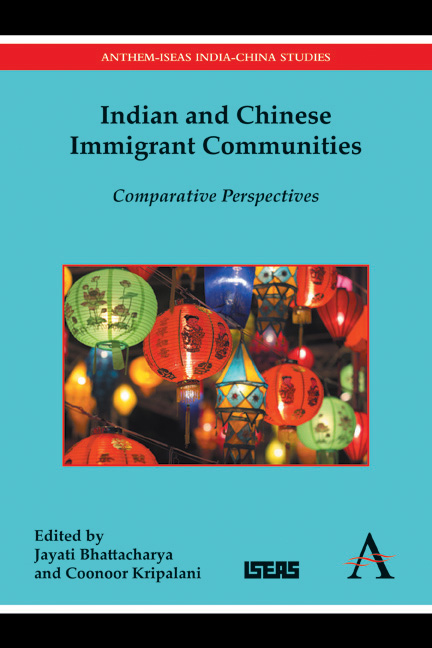Book contents
- Frontmatter
- Contents
- Foreword
- Acknowledgements
- Introduction
- Section I Historical Antecedents and the Question of Nationality
- Section II The Meeting Ground: Indians and Chinese in Southeast Asia
- 4 China's Nationality Laws and the Chinese Overseas
- 5 A Comparison of the Home Remittance Systems of Indian and Chinese Migrants in Southeast Asia: Nineteenth and Twentieth Centuries
- 6 Identity, Transnationalism and Corporate Development: Chinese Business in Malaysia
- 7 Beyond the Glitterati: The Indian and Chinese Jewellers of Little India, Singapore
- 8 Indian and Chinese Communities in Contemporary Burma: A Comparative Analysis of Their Presence and Influence
- 9 Expressions of Faith in Hindu Processional Festivals: Case Studies from Singapore and Malaysia
- 10 Beyond Boundaries? Hindu Spaces in the Chinatowns of Kolkata and Singapore
- Section III Indians in China and Chinese in India
- Section IV Across the Globe: Indian and Chinese Diasporas
- Postscript Shifting Worlds and Changing Identities: The Reshaping of the Chinese-Indian Communities in India after the 1962 “Sino-Indian Incident”
- List of Contributors
- Index
7 - Beyond the Glitterati: The Indian and Chinese Jewellers of Little India, Singapore
from Section II - The Meeting Ground: Indians and Chinese in Southeast Asia
Published online by Cambridge University Press: 05 December 2015
- Frontmatter
- Contents
- Foreword
- Acknowledgements
- Introduction
- Section I Historical Antecedents and the Question of Nationality
- Section II The Meeting Ground: Indians and Chinese in Southeast Asia
- 4 China's Nationality Laws and the Chinese Overseas
- 5 A Comparison of the Home Remittance Systems of Indian and Chinese Migrants in Southeast Asia: Nineteenth and Twentieth Centuries
- 6 Identity, Transnationalism and Corporate Development: Chinese Business in Malaysia
- 7 Beyond the Glitterati: The Indian and Chinese Jewellers of Little India, Singapore
- 8 Indian and Chinese Communities in Contemporary Burma: A Comparative Analysis of Their Presence and Influence
- 9 Expressions of Faith in Hindu Processional Festivals: Case Studies from Singapore and Malaysia
- 10 Beyond Boundaries? Hindu Spaces in the Chinatowns of Kolkata and Singapore
- Section III Indians in China and Chinese in India
- Section IV Across the Globe: Indian and Chinese Diasporas
- Postscript Shifting Worlds and Changing Identities: The Reshaping of the Chinese-Indian Communities in India after the 1962 “Sino-Indian Incident”
- List of Contributors
- Index
Summary
Introduction
The extraordinary variations presented by the ethnic structures of Southeast Asia make an interesting and complex area of research. The historical legacies, local cultures and traditions contribute to distinguish the Asian cities from their Western counterparts, and each in turn with particularities of their own. In the larger background of the multicultural social setting in Singapore, a predominantly ethnic Indian population in the landscape of Little India presents a fascinating dimension of shared “community space” as well as various aspects of “competing multiculturalisms” in a rapidly growing Asian city. If diasporic communities attempt to recreate a sociocultural version of their homeland in their memory and imagination, no other setting could be more pertinent than the visual construct of Little India in Singapore. It presents to us all the elements of being Indian – saris, sweets, spices, flowers, deities, Indian provisions, utensils and gold ornaments! Though the area is dominated by migrants from South India as manifested by the Tamil lingua franca and most of the available consumer products in the area, it is also frequented by the migrants and expatriates from North India and other parts of the Indian subcontinent. There are also a few well-established North Indian businesses in the area, like the Mustafa Centre and Meena Gold Jewellery. The common grounds in products and preferences as well as in the sharing of community space have been comfortably worked out between businessmen and the general ethnic Indian clientele. They manage to fit in quite well in the negotiation of their demands and supplies of everyday culinary ingredients, provisions, necessities of religious obligations and festive decorations. However, the overall impact of the whiffs of Indian cuisine, incense sticks, flowers and garlands and the blaring Indian movie songs undoubtedly have a mesmerizing effect, transporting one to some place in India until one suddenly hears “ok, la!” and is jolted back to the reality of an interactive shared space in Singapore.
- Type
- Chapter
- Information
- Indian and Chinese Immigrant CommunitiesComparative Perspectives, pp. 91 - 108Publisher: Anthem PressPrint publication year: 2015



